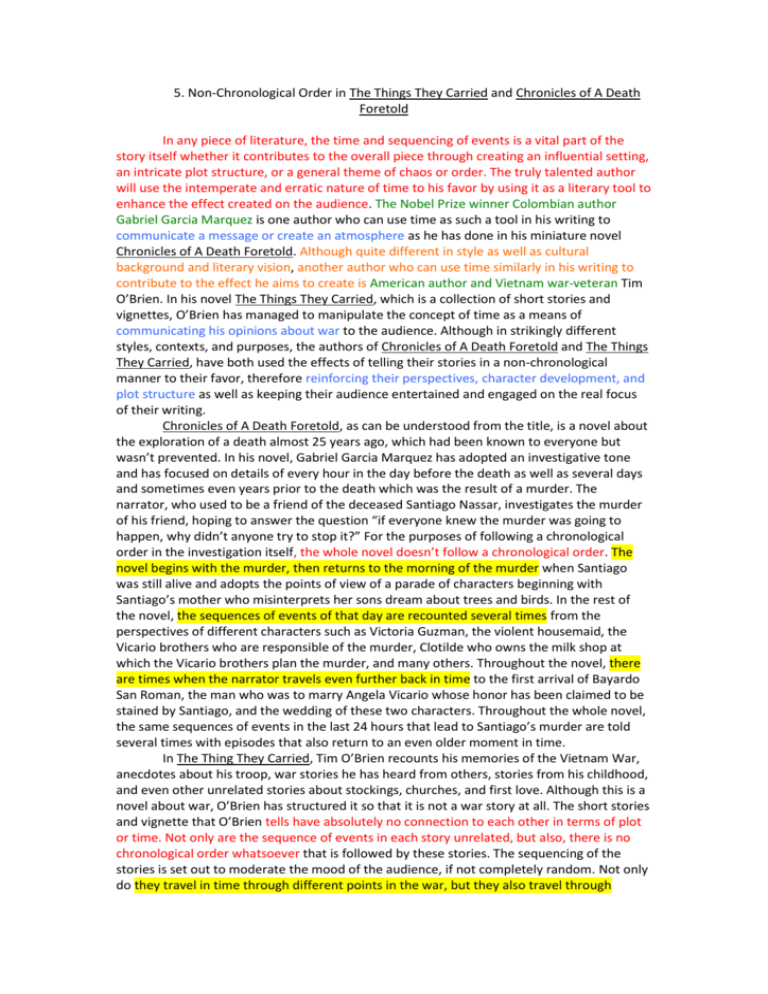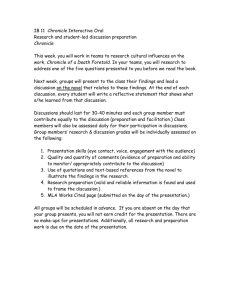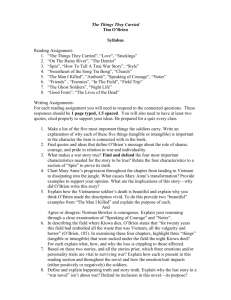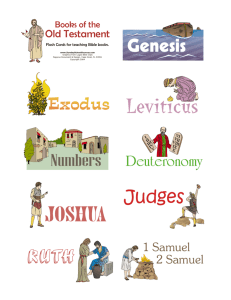Non-Chronological Order in Literature: Marquez & O'Brien
advertisement

5. Non-Chronological Order in The Things They Carried and Chronicles of A Death Foretold In any piece of literature, the time and sequencing of events is a vital part of the story itself whether it contributes to the overall piece through creating an influential setting, an intricate plot structure, or a general theme of chaos or order. The truly talented author will use the intemperate and erratic nature of time to his favor by using it as a literary tool to enhance the effect created on the audience. The Nobel Prize winner Colombian author Gabriel Garcia Marquez is one author who can use time as such a tool in his writing to communicate a message or create an atmosphere as he has done in his miniature novel Chronicles of A Death Foretold. Although quite different in style as well as cultural background and literary vision, another author who can use time similarly in his writing to contribute to the effect he aims to create is American author and Vietnam war-veteran Tim O’Brien. In his novel The Things They Carried, which is a collection of short stories and vignettes, O’Brien has managed to manipulate the concept of time as a means of communicating his opinions about war to the audience. Although in strikingly different styles, contexts, and purposes, the authors of Chronicles of A Death Foretold and The Things They Carried, have both used the effects of telling their stories in a non-chronological manner to their favor, therefore reinforcing their perspectives, character development, and plot structure as well as keeping their audience entertained and engaged on the real focus of their writing. Chronicles of A Death Foretold, as can be understood from the title, is a novel about the exploration of a death almost 25 years ago, which had been known to everyone but wasn’t prevented. In his novel, Gabriel Garcia Marquez has adopted an investigative tone and has focused on details of every hour in the day before the death as well as several days and sometimes even years prior to the death which was the result of a murder. The narrator, who used to be a friend of the deceased Santiago Nassar, investigates the murder of his friend, hoping to answer the question “if everyone knew the murder was going to happen, why didn’t anyone try to stop it?” For the purposes of following a chronological order in the investigation itself, the whole novel doesn’t follow a chronological order. The novel begins with the murder, then returns to the morning of the murder when Santiago was still alive and adopts the points of view of a parade of characters beginning with Santiago’s mother who misinterprets her sons dream about trees and birds. In the rest of the novel, the sequences of events of that day are recounted several times from the perspectives of different characters such as Victoria Guzman, the violent housemaid, the Vicario brothers who are responsible of the murder, Clotilde who owns the milk shop at which the Vicario brothers plan the murder, and many others. Throughout the novel, there are times when the narrator travels even further back in time to the first arrival of Bayardo San Roman, the man who was to marry Angela Vicario whose honor has been claimed to be stained by Santiago, and the wedding of these two characters. Throughout the whole novel, the same sequences of events in the last 24 hours that lead to Santiago’s murder are told several times with episodes that also return to an even older moment in time. In The Thing They Carried, Tim O’Brien recounts his memories of the Vietnam War, anecdotes about his troop, war stories he has heard from others, stories from his childhood, and even other unrelated stories about stockings, churches, and first love. Although this is a novel about war, O’Brien has structured it so that it is not a war story at all. The short stories and vignette that O’Brien tells have absolutely no connection to each other in terms of plot or time. Not only are the sequence of events in each story unrelated, but also, there is no chronological order whatsoever that is followed by these stories. The sequencing of the stories is set out to moderate the mood of the audience, if not completely random. Not only do they travel in time through different points in the war, but they also travel through decades to the present or O’Brien’s childhood or his youth before he is drafted in Vietnam. While one short story “On the Rainy River”, that is placed in the beginning of the book, takes place right before he leaves for the war, the last short story is about O’Brien’s first love from when he was 8 years-old, and in the middle of stories about the war, there is one short story about O’Brien’s conversation with Jimmy Cross about Martha many years after the war is over. Throughout the novel, each short story is told independently in term of time from another, and the sequencing of the stories almost never follows a chronological order. Among all the cultural, contextual, and thematic differences between the novels Chronicles of A Death Foretold and The Things They Carried, one main aspect that makes them very similar is their non-chronological sequencing of events. Character development is not important to either author, however through each fluctuation in time, they get the chance to introduce new characters, therefore obtaining a crowd of characters that only serve the purpose of contributing to the plot. In novels that follow chronological order, the author often gets the chance to explore a couple of characters in depth by following them throughout their development over time, but both Gabriel Garcia Marquez and Tim O’Brien prefer a richness of plot or theme rather than in depth characters. The fact that each time around, a new character’s perspective of the day of the murder is explored in Chronicles of A Death Foretold allows the reader to not get involved with any single character, but instead shape the event of the murder and the mystery that surrounds it with more detail. Similarly, the characters that take part change almost in each story in The Things They Carried, and this allows Tim O’Brien to communicate the more important idea that war is hell to his audience without focusing on the specific effects of war on each character, therefore achieving a more rounded, theme-oriented novel. Also, both authors use the lack of chronological order in order to replace it with “perspective”, which unlike the concept of time, still gives the audience to interpret and piece together events and ideas, but in addition removes the indecisiveness of the objectivity of structuring a piece around time. Adding the subjectivity of the narrator’s choice of the sequences of events and introduction of characters in Chronicles of A Death Foretold, as well as the choice of Tim O’Brien’s own manipulation of the sequencing of the stories gives the reader a chance to think about the importance of the events according to the authors and explore the reasons behind such sequencing as a means of communication between the author and the reader. Most importantly, in both pieces of literature, the lack of chronological order is used to serve the purpose of the style and form of the writing. Since Chronicle of A Death Foretold is written especially to sound like a detailed, thorough police investigation, the constant cycling of time around the events that are related to the murder enhance that feeling of formality and curiosity since it emphasizes that the focus of the novel is on answering some questions about one single event. Also, in The Things They Carried, the whole piece is built on communicating to the audience the chaos of war, and O’Brien uses a chaos in time and a non-existent chronological order of events to express the meaningless, irrational, and disorder nature of war. Both authors therefore use a non-chronological manner in their writing to emphasize the style or message they are trying to convey. Both novels use a nonchronological order with the purposes of not boring their audience as well since the monotonous negativity of the Vietnam war and its pain has the danger of losing its audience to pessimism and boredom while the constant focus on details in Chronicles of a Death Foretold also has the risk of losing the audience in the details. So both of the novels choose to keep entertainment and engagement in their disorderly use of time. The nonchronological manner used by both authors work in favor of their writing in shockingly similar ways. Although both novels adopt a similar non-chronological manner, they do so in a different way and with different purposes. In Chronicles of A Death Foretold, although a conventional chronology is absent, the sequencing of events still has some order to it as a way of expressing the formality and goal-oriented nature of the narrator’s investigation. The aim behind the lack of chronological order is to create another chronological order that is unconventional but more practical for the purposes of investigating Santiago’s murder. While in The Things They Carried, this order is absent and the whole point is to completely dismiss chronological stability, Chronicles of A Death Foretold adopts its own chronological order simply to keep consistent with its own unique style. Also, Chronicles of A Death Foretold begins with the main event, which is murder, and ends at the present with a thought-provoking evaluation of events, however The Things They Carried doesn’t have a set beginning and it simply dives into a short story about a very general explanation of the novel’s title and about Jimmy Cross’s unrequited love for Martha. Unlike Chronicles of A Death Foretold, The Things They Carried simply dismisses the idea of any order in chronology. When the narrator returns to the near past or travels to the present in Chronicles of A Death Foretold, it usually has the purpose of explaining a phenomenon expressed earlier, explain the reason of some happening, or give required information. For example, while investigating Santiago’s death, the author refers to the white clothing Santiago wore, and how he was out very early the morning of his murder, and for this he travels forward to the arrival of a religious figure and his greeting, but then returns to Santiago’s departure from his house in order to explain how he left through another door in the house and couldn’t see the note left under the front door warning him about the danger. However, in The Things They Carried, when some stories are left at critical points such as Kiowa’s death, or the referral to the “man the author had killed”, stories with much less relevance such as the short story about Henry Dobbins’s girlfriend’s stockings intervene and important information is left untold or postponed. Although neither novel follows a chronological order, Chronicles of A Death Foretold gives more importance to chronology compared to The Things They Carried. Even though it seems as if time has no important role in The Things They Carried, it has a major part in contributing to the theme and the concept of chaos in this novel in contrast with the more structural and technical use of a non-chronological manner in Chronicles of A Death Foretold. Tim O’Brien especially emphasizes the dismissal of any chorological sense in his novel because he uses it as a representation of his opinion that war is chaos. He places stories in irrelevant and irrational places in his novel with the special purpose of creating confusion in the audience, and later relates that confusion with that present in war. In Chronicles of A Death Foretold, chronology is not used as such a physical tool, but rather as a way of further emphasizing the plot. Also in The Things They Carried, the author uses the specific placement of stories as a way to manipulate the mood of the reader and place comic relief stories or stories about happiness and love in places where the war stories become too dark and depressing in order to balance out the mood of the audience. This can bee exemplified by the placement of a sequence of 5 very short vignettes including “Church”, “Love”, and “Stockings” in the midst of dramatic stories such as “The Man I Killed”, and “On the Rainy River”. This use makes a chronological sequencing impossible in The Things They Carried, therefore making the non-chronological manner different from and more strictly necessary than that in Chronicles of A Death Foretold. Writers of fiction don’t always relate events in a chronological order, and the use of this non-chronological manner as a way to enhance writing can be best seen in Gabriel Garcia Marquez’s Chronicles of A Death Foretold and Tim O’Brien’s The Things They Carried. In both of these novels, a chronological order is not followed and while in Chronicles of A Death Foretold, a different sequential order is adopted for the purposes of plot, in The Things They Carried, a sense of order in time is completely dismissed as a representation of chaos. Both authors use this non-chronological manner as a means of keeping their audience engaged and entertained, as well emphasizing the aspects of plot and character use that they find necessary. However, their use of a non-chronological manner is also different from one another’s since they use different styles of communication with the audience, and completely different cultural contexts. Nevertheless, both their usage of an absent chronology enhances the literary value of their writing. Naz Akyol








